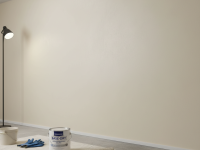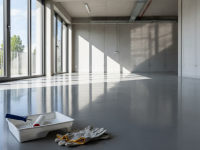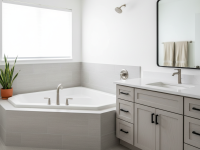Hey there, fellow homeowner! Are you tired of looking at those ever-increasing energy bills and wishing there was a magic wand to make them disappear? Trust me, you’re not alone. In today’s world, where everything seems to be getting pricier, finding ways to save money at home feels more important than ever. The good news? You don’t need a magic wand. You just need a little know-how and a willingness to make a few smart changes. And the best part? Many energy-saving home improvements don’t just save you money eventually; they pay for themselves so fast, you’ll wonder why you didn’t do them sooner!
I’ve been down this road myself. After staring at one too many intimidating utility statements, I decided it was time to get proactive. I started researching, trying out different tips, and yes, even getting my hands a little dirty. What I discovered was a handful of genuinely impactful upgrades that not only slashed my monthly energy consumption but also paid back their initial cost within a year – sometimes even faster! These aren’t huge renovations; they’re clever, accessible changes that make a real difference. Ready to dive in and see how you can start saving? Let’s go!
Understanding the “Under One Year Payback” Sweet Spot
Before we jump into the specifics, let’s talk about what “payback in under a year” really means. It means that the money you save on your utility bills over 12 months (or less) is equal to or greater than the cost of the improvement you made. It’s like getting a direct refund on your investment, and it feels incredibly satisfying. We’re looking for those low-cost, high-impact projects that give you immediate gratification and long-term savings.
When I started this journey, my main goal was to reduce my carbon footprint, but the financial savings quickly became a huge motivator. It’s amazing how a few small changes can add up to significant savings, especially when you consider the cumulative effect over months and years.
Quick Wins: Energy Improvements That Pay Off Fast
1. Embrace the Brilliance of LED Lighting
This is probably the most talked-about energy-saving tip, and for good reason! If you’re still using old incandescent or even some CFL bulbs, switching to LEDs is an absolute no-brainer. The upfront cost for LED bulbs has come down dramatically, and the savings are almost instant.
- My Experience: I remember the first time I replaced all the incandescent bulbs in my living room with LEDs. The immediate difference in brightness was noticeable, but what truly amazed me was how little energy they used. My old bulbs used to feel hot to the touch; LEDs barely generate any heat. I calculated that by switching out just 15 bulbs, I was saving roughly $75-$100 aually on electricity. The cost of those bulbs? Around $40-$60. That’s a payback in 6-8 months!
- Why it Pays Off: LEDs use up to 90% less energy than incandescents and last 25 times longer. Less energy consumed means lower bills. Plus, they produce less heat, which helps reduce the load on your air conditioning in warmer months.
- Actionable Tip: Don’t try to replace everything at once if your budget is tight. Start with the lights you use most often – kitchen, living room, hallways. You’ll see the savings almost immediately.
2. Get Smart with a Programmable or Smart Thermostat
Your HVAC system is likely the biggest energy hog in your home. A smart thermostat can be your best friend in taming those costs, especially if you’re not consistently adjusting your temperature manually.
- My Experience: I was skeptical at first, thinking “Can’t I just manually adjust it?” But a friend convinced me to try a smart thermostat. The ability to program it to automatically adjust temperatures when I’m at work or asleep, and even control it from my phone before I get home, was a game-changer. My heating and cooling costs dropped by about 10-15% aually. For a thermostat costing around $150-$250, that meant a payback in less than a year, especially given my region’s hot summers and cold winters.
- Why it Pays Off: These devices learn your preferences and schedule, optimizing your home’s temperature when you need it and conserving energy when you don’t. Some models even coect to local weather forecasts to pre-heat or pre-cool your home efficiently.
- Actionable Tip: Look for models that are ENERGY STAR certified. Many utility companies also offer rebates for installing smart thermostats, further reducing your upfront cost and speeding up your payback!
3. Seal the Deal: Weatherstripping and Caulking
This is arguably the cheapest and most overlooked energy-saving improvement, yet it delivers incredible returns. Air leaks around windows and doors are like leaving a small window open all the time, constantly letting your expensive heated or cooled air escape.
- My Experience: After a particularly drafty winter, I decided to tackle this head-on. A few tubes of caulk and a roll of self-adhesive weatherstripping cost me less than $50. I spent a Saturday afternoon meticulously sealing gaps around my window frames and replacing old, worn-out door seals. The difference was astonishing! My home felt noticeably warmer, and my furnace wasn’t cycling as frequently. That winter, my heating bill dropped by about 7-10% compared to the previous year. My investment literally paid for itself in a couple of months.
- Why it Pays Off: Preventing drafts can save 5-10% on heating and cooling costs. It’s a small investment with a huge impact on comfort and utility bills.
- Actionable Tip: Do the “candle test” or “smoke test” around windows and doors on a windy day. If the flame flickers or smoke moves, you’ve found a leak!
4. Insulate Your Hot Water Pipes
If your hot water pipes run through unheated spaces like a basement or garage, they’re losing heat before the water even reaches your tap or shower. Insulating them is a simple and inexpensive fix.
- My Experience: My hot water heater is in the basement, and I noticed the pipes leading out of it felt warm even wheot in use. I bought some foam pipe insulation (the kind that’s pre-slit and just snaps on) for about $20. It took me less than an hour to cut and fit it around the first few feet of both the hot and cold water pipes leading from the heater. The result? Water felt hotter faster, meaning I didn’t have to run the tap as long, saving both water and the energy used to heat it. I estimate this paid for itself in about 4-6 months by reducing water heating costs.
- Why it Pays Off: Insulating pipes reduces heat loss, so hot water arrives faster and stays hot longer. This means your water heater doesn’t have to work as hard, saving energy and money.
- Actionable Tip: Focus on the first six feet of both the hot and cold water pipes coming out of your water heater, and any hot water pipes ruing through unconditioned spaces.
5. The Power of Smart Power Strips
We’ve all heard of “phantom load” or “vampire power” – the electricity devices consume even when turned off but still plugged in. Think TVs, gaming consoles, phone chargers, coffee makers. A smart power strip can help you slay these energy vampires.
- My Experience: I have a home office with a computer, two monitors, a printer, and several other peripherals. Even when turned off, they were drawing power. I invested in a smart power strip that had a “master” outlet (for the computer) and “slave” outlets. When the computer was turned off, the strip automatically cut power to the monitors and printer. It cost about $30-$40, and given the number of devices, I saw a noticeable dip in my baseline electricity usage. Depending on how many devices you have, this can pay off in 6-12 months.
- Why it Pays Off: By completely cutting power to devices when they’re not in use, smart power strips eliminate phantom load, which can account for 5-10% of your household electricity consumption.
- Actionable Tip: Identify the areas in your home with multiple electronic devices (e.g., entertainment centers, home offices) and outfit them with smart power strips.
6. Swap to Low-Flow Showerheads
This isn’t just about saving water; it’s about saving the energy used to *heat* that water. If you have older showerheads, they could be gushing out more water than you need.
- My Experience: My old showerhead was definitely a powerful one, but also a thirsty one. Swapping it out for an inexpensive low-flow model (around $20-$40) was incredibly easy – just screw off the old one, screw on the new. The modern low-flow showerheads deliver a surprisingly strong and satisfying spray, not the weak dribble you might imagine. My family of four saw a reduction in our water heating costs by roughly $5-$10 a month. That’s a payback in 2-8 months, purely from the energy savings, not even counting the water bill!
- Why it Pays Off: Reduces both water consumption and the energy needed to heat that water, leading to double the savings.
- Actionable Tip: Look for showerheads with a flow rate of 2.5 gallons per minute (gpm) or less. Many are designed to maintain good pressure despite the lower flow.
The Takeaway: Small Steps, Big Impact
See? You don’t need to break the bank or undertake massive renovation projects to make a significant dent in your energy bills. These simple, low-cost home improvements offer quick returns on investment, often paying for themselves in well under a year. Beyond the financial savings, you’ll enjoy a more comfortable home, reduce your environmental footprint, and gain a real sense of accomplishment knowing you’ve taken control of your energy consumption.
I genuinely encourage you to pick just one or two of these suggestions and give them a try. You’ll be amazed at how quickly you start seeing the benefits. Your wallet, and the planet, will certainly thank you!




